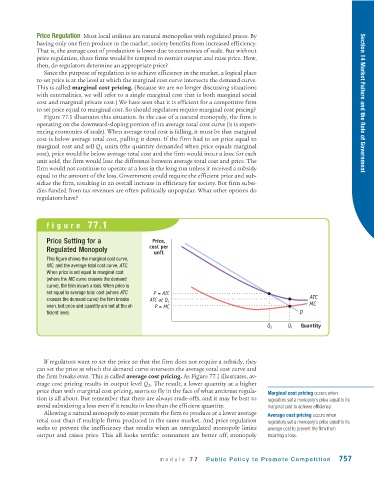Page 799 - Krugmans Economics for AP Text Book_Neat
P. 799
Price Regulation Most local utilities are natural monopolies with regulated prices. By
having only one firm produce in the market, society benefits from increased efficiency.
That is, the average cost of production is lower due to economies of scale. But without
price regulation, these firms would be tempted to restrict output and raise price. How,
then, do regulators determine an appropriate price?
Since the purpose of regulation is to achieve efficiency in the market, a logical place
to set price is at the level at which the marginal cost curve intersects the demand curve.
This is called marginal cost pricing. (Because we are no longer discussing situations
with externalities, we will refer to a single marginal cost that is both marginal social
cost and marginal private cost.) We have seen that it is efficient for a competitive firm Section 14 Market Failure and the Role of Government
to set price equal to marginal cost. So should regulators require marginal cost pricing?
Figure 77.1 illustrates this situation. In the case of a natural monopoly, the firm is
operating on the downward-sloping portion of its average total cost curve (it is experi-
encing economies of scale). When average total cost is falling, it must be that marginal
cost is below average total cost, pulling it down. If the firm had to set price equal to
marginal cost and sell Q 1 units (the quantity demanded when price equals marginal
cost), price would be below average total cost and the firm would incur a loss: for each
unit sold, the firm would lose the difference between average total cost and price. The
firm would not continue to operate at a loss in the long run unless it received a subsidy
equal to the amount of the loss. Government could require the efficient price and sub-
sidize the firm, resulting in an overall increase in efficiency for society. But firm subsi-
dies funded from tax revenues are often politically unpopular. What other options do
regulators have?
figure 77.1
Price Setting for a Price,
cost per
Regulated Monopoly
unit
This figure shows the marginal cost curve,
MC, and the average total cost curve, ATC.
When price is set equal to marginal cost
(where the MC curve crosses the demand
curve), the firm incurs a loss. When price is
set equal to average total cost (where ATC P = ATC
crosses the demand curve) the firm breaks ATC at Q 1 ATC
even, but price and quantity are not at the ef- P = MC MC
ficient level. D
Q 2 Q 1 Quantity
If regulators want to set the price so that the firm does not require a subsidy, they
can set the price at which the demand curve intersects the average total cost curve and
the firm breaks even. This is called average cost pricing. As Figure 77.1 illustrates, av-
erage cost pricing results in output level Q 2 . The result, a lower quantity at a higher
price than with marginal cost pricing, seems to fly in the face of what antitrust regula- Marginal cost pricing occurs when
tion is all about. But remember that there are always trade-offs, and it may be best to regulators set a monopoly’s price equal to its
avoid subsidizing a loss even if it results in less than the efficient quantity. marginal cost to achieve efficiency.
Allowing a natural monopoly to exist permits the firm to produce at a lower average Average cost pricing occurs when
total cost than if multiple firms produced in the same market. And price regulation regulators set a monopoly’s price equal to its
seeks to prevent the inefficiency that results when an unregulated monopoly limits average cost to prevent the firm from
output and raises price. This all looks terrific: consumers are better off, monopoly incurring a loss.
module 77 Public Policy to Promote Competition 757

